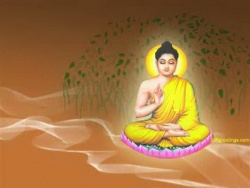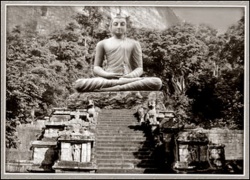The Eighth Gyara Tulku, Lobzang Tendzin Chokyi Wangchuk
The Eighth Gyara Tulku, Lobzang Tendzin Chokyi Wangchuk (rgya ra sprul sku 08 lo bzang bstan 'dzin chos kyi dbang phyug) was born in Drayab (brag gyab) in Kham in 1918, the earth-horse year of the fifteenth sexagenary cycle.
His father was named Norbu Gyeltsen (nor bu rgyal tshan) and his mother was named Jamyang Dolma ('jam byangs sgrol ma).
According to his hagiography, his identification as the reincarnation of the Seventh Gyara Tulku Pakchok Tubten Jigme Chokyi Wangchuk (rgya ra sprul sku 07 'phags mchog thub bstan 'jigs med chos kyi dbang phyug, 1842-1913) was done with help of a prophecy by Chamdo Zhangpen (chab mdo zhang paN) the dharmapala of Chamdo, and a handwritten note of prophecy regarding the birth of his reincarnation by the Seventh Gyara Tulku. This note, which predicted the mother's name, the child's birth-sign and so forth, was said to have been found hidden among the miscellaneous books shelved in the residence of Gyara Tulkus. Nevertheless, there were several potential candidates, and the formal identification was made by the Thirteenth Dalai Lama, Tubten Gyatso (ta la'i bla ma 13 thub bstan rgya mtsho, 1876-1933) by use of divination. Subsequently, the young boy was brought to his monastery Drugu Tang Drubde (gru gu thang sgrub sde), which had been founded in 1566 by the First Gyara Tulku, Drubchen Sherab Puntsok (rgya ra 01 grub chen shes rab phun tshogs, 1566-1632) and had been the main seat of his incarnation line.
Chokyi Wangchuk started his education and training with Zonglo Tulku Konchok Jungne (rdzong blo sprul sku dkon mchog 'byung gnas, d.u.) who served as his chief tutor. He also received many teachings from Tokden Jamyang Lodo (rtogs ldan 'jam dbyangs blo gros, d.u.) such as Lamrim (lam rim). At the age of eighteen, he travelled to U-Tsang and enrolled in the Loseling College of Drepung Monastic University ('bras spungs blo gsal gling grwa tshang) for further studies. There in Drepung he studied the five traditional texts of the Geshe degree under Geshe Tongpon (dge shes stong dpon, d.u.) who served as his chief tutor and later gave him full monastic ordination.
In addition to his principal tutor, Geshe Tonpon]], Chokyi Wangchuk received a wide range of teachings, transmissions, initiations, empowerments, and instructions from a number of outstanding lama scholars.
Among these were Pabongkha Dechen Nyingpo (pha bong kha bde chen snying po, 1878-1941); Kyabje Khangsar Dorjechang (skyabs rje khang gsar rdor rje 'chang, d.u.); the Fifth Lingtrul, Tubten Lungtok Tendzin Trinle (gling sprul 05 thub bstan lung rtogs bstan 'dzin 'phrin las, 1903-1983), the senior tutor of of the Fourteenth Dalai Lama, Tendzin Gyatso (ta la'i bla ma 14 bstan 'dzin rgya mtsho b. 1935); and the Third Trijang, Lobzang Yeshe Tendzin Gyatso (khri byang 03 blo bzang ye shes bstan 'dzin rgya mtsho, 1900-1981), the junior tutor of the Fourteenth Dalai Lama.
After spending considerably long time in U-Tsang Chokyi Wangchuk returned to his monastery in Kham, and sat in intensive retreat in the remote hermitage of Gaden Tarpeling (dban gnas dga' ldan thar pa gling) and subsequently for an extended period of time at the remote hermitage of Paktse Ritro (dban gnas dpak tshad ri khrod).
At the request of the Kālacakra College of Chamdo Jampa Ling (byams pa gling gyi dus 'khor grwa tshang), Gyara Tulku gave a complete empowerment on Kālacakra Tantra and numerous other empowerments and transmissions of various tantric systems. He also gave a White Tārā long-life empowerment to a public gathering of over ten thousand people.
Besides Chamdo Jampa Ling, Gyara Tulku visited the monasteries in the Chamdo region and gave general teachings, commentaries, and also initiations and empowerments on Yamāntaka, Cakrasaṃvara, Guhyasamāja, Kālacakra, and so forth.
Some of the frequently visited monasteries in Southern Kham include:
Zhitam Gonpa (gzhi bkram dgon pa),
Zito (rdzi tho dgon),
Ngodu Monastery (ngo 'du dgon),
Japu (bya phud dgon),
Wong (dbang dgon),
Shopado Gonpa (sho pa mdo dgon pa),
Poti (po ti dgon),
Chakra Monastery (lcags ra dgon),
Wikcho Dzong (wig chos rdzong),
Pelber (dpal 'bar dgon),
Ramatang (ra ma thang dgon),
Lhatse (lha rtse dgon),
Bajong (ba ljong dgon) and so forth.
In 1958, the earth-dog year of the sixteenth sexagenary cycle, he gave a comprehensive commentarial transmission on Lamrim Chenmo at Zhitam Monastery to more than four thousand follower monks gathered from over fifty monasteries in the region.
In 1959, following the failed Tibetan uprising against Chinese Communist rule in Tibet, Chokyi Wangchuk fled to India with other monks of Drepung including Chakzo Yeshi (phyag dzod ye shes), his Personal Manager, and Geshe Puntsok Dondup (dge shes phun tshogs don grub), currently an Associate Professor in the Central University of Tibetan Studies, Varanasi, India.
Short after his arrival in India he settled in a small town called Bomdila in the Himalayas under the State of Arunachal Pradesh in India. He established a small lama residence (rgya ra blab brang) in Bomdila and spent his remaining life mainly in dharma practice and the performance of religious activities for the local devotees as the town.
Monpas and Lopas, the local inhabitants, follow Tibetan Buddhism. Finally in 1976, at the age of fifty-nine, on the twenty-eighth day of the fifth month of fire-dragon year of the sixteenth sexagenary cycle, he passed into nirvana at his residence.
Tubten Jampel Lekshe Gyatso (thub bstan 'jam dpal legs bsad rgya mtsho), born in India in 1979 into the family of Tendzin Chodak (bstan 'dzin chos grags) from Chamdo and his Skimese wife Tangkyi ('bras ljongs pa thang skyid), was identified by the Fourteenth Dalai Lama as the reincarnation of the Eighth Gyara Tulku. Chakzo Yeshi moved permanently with the boy to Drepung Loseling Monastery in Bylakuppe in South India where they have a permanent lama residence.
Source
Byams pa chos grags. N.d. Chab mdo byams pa gling gi gdan rabs. Chamdo: Chab mdo par 'debs bzo grwa par btab, pp. 454-58.
Samten Chhosphel
August 2010

